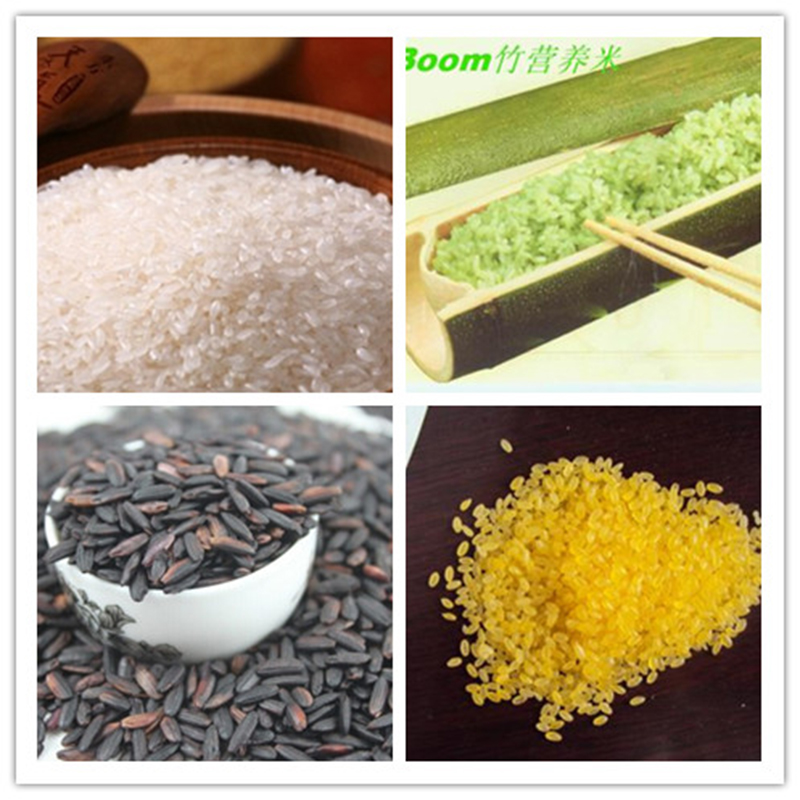The process of reconstituted rice / nutrition rice / Artificial Rice production line
The process of reconstituted rice / nutrition rice / Artificial Rice production line
The artificial rice produced by the twin screw extruder is made from broken rice as raw material, which is ground through the crushing process to form fine rice flour. Artificial rice is made from the flour and is processed through processes such as adding water, stirring, expanding, cooling, drying, and sieving. Its appearance looks like rice. Artificial rice made from yellow corn is light yellow, while white jade rice is white, both in a semi expanded state with a certain degree of transparency, Rice made with this type of corn is more delicious than rice made with corn flour or corn residue. Currently, there are various types of commercially available rice, including added sugar, lysine, and vitamins, making it an extremely convenient food
Raw material processing: Use standard NO.2 rice as the raw material, remove the rice bran, weigh, and immerse it in water in a rice trough. The water content should cover the rice by 10 centimeters. Soak for half an hour, add water to the basket under the rice soaking tank, stir while placing, and rinse with clean water. Put the washed rice in the basket for 2-4 hours (the soaking time should be short in winter, and the standing drainage time can be extended appropriately), drain the excess water in the rice (so that the water content is less than 30%), and then crush the rice into dry grinding powder with a flour mill. The dry grinding powder is screened by a reciprocating vibrating screen (50 meshes) and falls into the powder holding tank. Dry grinding powder stays here for more than half an hour to allow the surface moisture of the powder particles to penetrate into the interior, achieving a uniform distribution of internal and external moisture. Simultaneously take samples to determine the moisture content of dry grinding powder.

Cooking and shaping: Weigh the sieved dry ground powder. Each 40kg batch is poured into the mixing cooking drum. According to the measured water content of dry grinding powder, the water to be added is exchanged to make the powder extruded into Rice noodles with a diameter of 0.6mm. The powder is extruded from the orifice plate of the press to form four Rice noodles belts, which fall on the cooling conveyor belt with a length of 1 meter synchronously, sent to the cutter, cut into 22 cm long Rice noodles sections, folded into U-shaped blocks, laid flat on the porous aluminum plate, placed in the cooking cabinet, steamed for 10-16 minutes, and then transferred to the drying room.
Drying detection: after the second cooking, the Rice noodles are loaded onto the drying car, pushed into the drying tunnel in the drying room with the car connected, and pulled by the winch, so that the drying car moves forward slowly in the direction of countercurrent wind. The humidity of the hot air in the drying room is 40 ± 2 ℃, and the air volume is 7425 m3/hour. Bake Rice noodles in the drying room for 3-5 hours until the moisture content is 11-13%. Push out the drying truck, and first conduct sensory test on Rice noodles. If there is any unqualified person, select another one to put and degrade it. If the qualified person is put into a plastic bag for sealing, or use cellophane packaging to seal the unqualified person, select another one to put and degrade it. If the qualified person is put into a plastic bag for sealing, or use cellophane packaging to seal. Then, the physical and chemical indicators of Rice noodles shall be sampled and inspected by personnel. The batches that meet the standard are qualified products, which are accepted and warehoused.





